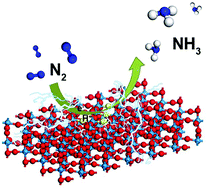The Haber–Bosch process for industrial-scale NH3 production suffers from harsh conditions and serious CO2 release. Electrochemical N2 reduction is an alternative approach to synthesize NH3 under ambient conditions, but it requires highly-efficient electrocatalysts for the N2 reduction reaction (NRR). In this Communication, we demonstrate that WO3 nanosheets rich in oxygen vacancies (R-WO3 NSs) exhibit greatly enhanced NRR performances. In 0.1 M HCl, such R-WO3 NSs achieve a large NH3 yield of 17.28 μg h−1 mgcat.−1 and a high faradaic efficiency of 7.0% at −0.3 V vs. a reversible hydrogen electrode, much superior to the WO3 nanosheets deficient in oxygen vacancies (6.47 μg h−1 mgcat.−1 and 1.02%). Remarkably, R-WO3 NSs also show high electrochemical stability.
